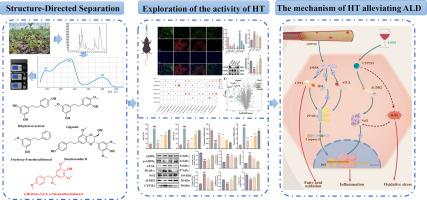Bibenzyls from Dendrobium huoshanense attenuate alcohol-associated liver disease via AMPK/ATGL, CYP2E1/ALDH2, and gut microbiota modulation
IF 8.3
1区 医学
Q1 CHEMISTRY, MEDICINAL
引用次数: 0
Abstract
Background
Dendrobium huoshanense, a renowned traditional Chinese medicine, is widely used for liver disease prevention and treatment, exhibiting potential therapeutic effects against alcohol-associated liver disease (ALD). However, its specific active components and mechanisms of action remain unclear.
Purpose
This study aimed to isolate bibenzyl compounds from D. huoshanense via structure-guided separation, identify the core active component for ALD treatment, and elucidate its underlying mechanism.
Methods
Bibenzyl compounds were isolated using preparative HPLC. An in vitro HepG2 cell injury model induced by ethanol/palmitic acid was employed for bioactivity screening. The anti-ALD effects of the active component were comprehensively evaluated in an ALD mouse model and cellular experiments. Integrated multi-omics strategies (liver proteomics, gut microbiota 16S rRNA sequencing) combined with molecular biology techniques (Western blotting, immunofluorescence) were utilized to decipher the core molecular mechanisms.
Results
Five bibenzyl compounds were isolated and identified from D. huoshanense. Among them, 4-hydroxy-3,4′,5, α-tetramethoxybibenzyl (HT) exhibited the most potent activity. HT exerted hepatoprotective effects through remodeled gut microbiota by increasing beneficial bacteria and restoring short-chain fatty acid production; activated the AMPK/PPAR-γ/ATGL pathway to promote lipolysis and reduce lipid droplet accumulation; and suppressed oxidative stress by inhibiting CYP2E1 overexpression while enhancing ALDH2 activity, thereby alleviating ethanol-induced oxidative damage.
Conclusion
Bibenzyl compounds are the primary active constituents of D. huoshanense for ALD treatment. HT, as the core component, exerts multi-target effects by synergistically modulating the gut-liver axis, lipid metabolism, and oxidative stress pathways, demonstrating significant potential as a novel therapeutic candidate for ALD.

霍山石斛的联苯通过AMPK/ATGL、CYP2E1/ALDH2和肠道微生物群调节来减轻酒精相关肝病。
背景:霍山石斛是一种著名的中药,广泛用于肝脏疾病的预防和治疗,对酒精相关性肝病(ALD)有潜在的治疗作用。然而,其具体的活性成分和作用机制尚不清楚。目的:本研究旨在通过结构引导分离方法分离霍山菌中联苯类化合物,鉴定治疗ALD的核心活性成分,并阐明其作用机制。方法:采用制备高效液相色谱法分离联苯类化合物。采用乙醇/棕榈酸诱导HepG2细胞体外损伤模型进行生物活性筛选。通过ALD小鼠模型和细胞实验综合评价活性成分的抗ALD作用。综合多组学策略(肝脏蛋白质组学,肠道微生物群16S rRNA测序)结合分子生物学技术(Western blotting,免疫荧光)来破译核心分子机制。结果:从霍山菌中分离鉴定出5个联苯化合物。其中,4 -羟基-3,4',5,α-四甲基氧基联苯(HT)活性最强。HT通过增加有益菌群和恢复短链脂肪酸的产生来重塑肠道菌群,发挥肝保护作用;激活AMPK/PPAR-γ/ATGL通路,促进脂肪分解,减少脂滴积聚;通过抑制CYP2E1过表达,增强ALDH2活性来抑制氧化应激,从而减轻乙醇诱导的氧化损伤。结论:联苯类化合物是霍山参治疗ALD的主要有效成分。HT作为核心成分,通过协同调节肠-肝轴、脂质代谢和氧化应激途径发挥多靶点作用,显示出作为ALD新候选治疗药物的巨大潜力。
本文章由计算机程序翻译,如有差异,请以英文原文为准。
求助全文
约1分钟内获得全文
求助全文
来源期刊

Phytomedicine
医学-药学
CiteScore
10.30
自引率
5.10%
发文量
670
审稿时长
91 days
期刊介绍:
Phytomedicine is a therapy-oriented journal that publishes innovative studies on the efficacy, safety, quality, and mechanisms of action of specified plant extracts, phytopharmaceuticals, and their isolated constituents. This includes clinical, pharmacological, pharmacokinetic, and toxicological studies of herbal medicinal products, preparations, and purified compounds with defined and consistent quality, ensuring reproducible pharmacological activity. Founded in 1994, Phytomedicine aims to focus and stimulate research in this field and establish internationally accepted scientific standards for pharmacological studies, proof of clinical efficacy, and safety of phytomedicines.
 求助内容:
求助内容: 应助结果提醒方式:
应助结果提醒方式:


